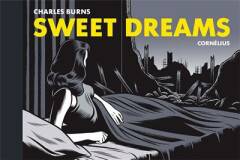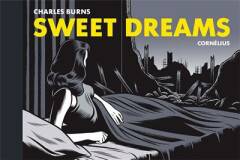
Je cadeautjes zeker op tijd in huis hebben voor de feestdagen? Kom langs in onze winkels en vind het perfecte geschenk!
- Afhalen na 1 uur in een winkel met voorraad
- Gratis thuislevering in België vanaf € 30
- Ruim aanbod met 7 miljoen producten
Je cadeautjes zeker op tijd in huis hebben voor de feestdagen? Kom langs in onze winkels en vind het perfecte geschenk!
- Afhalen na 1 uur in een winkel met voorraad
- Gratis thuislevering in België vanaf € 30
- Ruim aanbod met 7 miljoen producten
Zoeken
Omschrijving
Charles Burns never hid his interest in old corny comics and adolescent impulses. In Sweet Dreams he offers us a summary of his favorite themes through around fifty new illustrations. This series of drawings is inspired by a recurring motif, omnipresent in romantic comics of the 1950s and 1960s, the image of a young woman in her bed prey to the torments of love. Burns revisits this kitsch aesthetic by integrating it into his own universe. The dream then becomes the place of all passions. Previously gentle and idyllic, it now welcomes fears, anxieties and fantasies.
A massive commercial success in the United States between the 1950s and 1970s, romance comics were produced and distributed in several million copies. Aimed at young girls, they were usually written and drawn by middle-aged, mostly anonymous men.
In Sweet Dreams, Charles Burns plays, not without humor, with this male gaze which has shaped the collective imagination for a long time, to better question the representation of women in American comics. The watered-down image of the innocent young girl thus gives way to darker torments, giving back its surrealist letters to the unconscious. Between homage and diversion, this series of illustrations plunges us into disturbing dreams, which exert all their power of fascination.
A massive commercial success in the United States between the 1950s and 1970s, romance comics were produced and distributed in several million copies. Aimed at young girls, they were usually written and drawn by middle-aged, mostly anonymous men.
In Sweet Dreams, Charles Burns plays, not without humor, with this male gaze which has shaped the collective imagination for a long time, to better question the representation of women in American comics. The watered-down image of the innocent young girl thus gives way to darker torments, giving back its surrealist letters to the unconscious. Between homage and diversion, this series of illustrations plunges us into disturbing dreams, which exert all their power of fascination.
Specificaties
Betrokkenen
- Auteur(s):
- Uitgeverij:
Inhoud
- Aantal bladzijden:
- 104
- Taal:
- Nederlands
Eigenschappen
- Productcode (EAN):
- 9782360812233
- Verschijningsdatum:
- 13/11/2024
- Uitvoering:
- Paperback
- Afmetingen:
- 210 mm x 300 mm
- Gewicht:
- 673 g

Alleen bij Standaard Boekhandel
+ 71 punten op je klantenkaart van Standaard Boekhandel
Beoordelingen
We publiceren alleen reviews die voldoen aan de voorwaarden voor reviews. Bekijk onze voorwaarden voor reviews.









